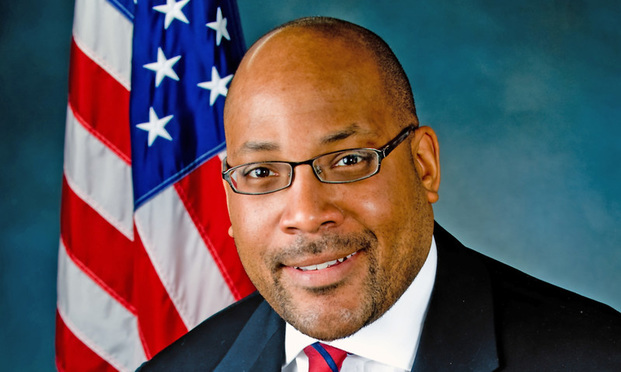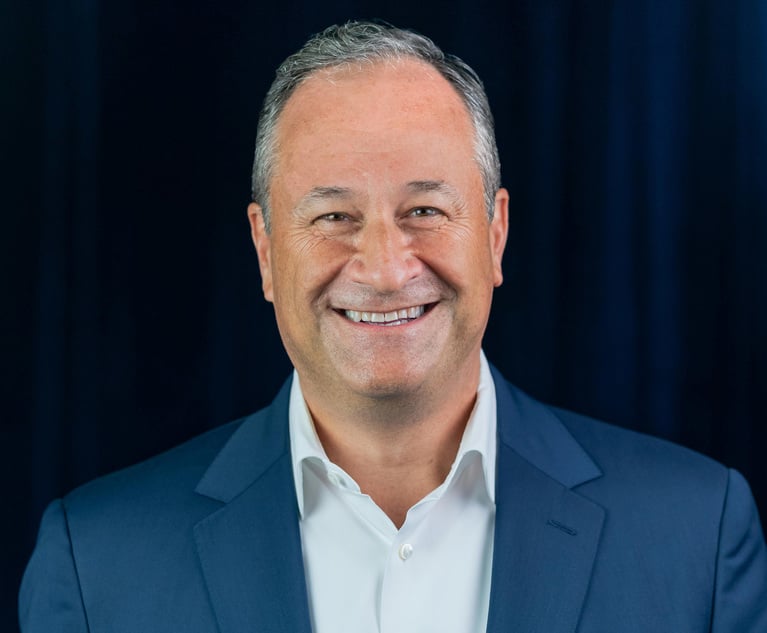Convicted Pol Says Gov't Presented Wrong Evidence for Obstruction
Prosecutors in the trial for former state Sen. John Sampson, who was sentenced to prison this year for obstruction and lying to the FBI, improperly presented evidence that Sampson tampered with witnesses to make the case for obstruction, his lawyer argued Thursday before a federal appeals court.
December 07, 2017 at 04:56 PM
5 minute read
 John Sampson.
John Sampson. Prosecutors in the trial for former state Sen. John Sampson, who was sentenced to prison this year for obstruction and lying to the FBI, improperly presented evidence that Sampson tampered with witnesses to make the case for obstruction, his lawyer argued Thursday before a federal appeals court.
But prosecutors counter that presenting evidence that Sampson—a once-powerful lawmaker in Albany who served a three-year stint as leader of the Senate Democrats—took steps to interfere with an investigation into a real estate developer who loaned Sampson money showed Sampson's corrupt intent with respect to the obstruction charge.
“By way of analogy, if a defendant steals a car with the intent to use it in a bank robbery, he is no less guilty of automobile theft because the government relies upon his intended use of the car to prove criminal intent,” prosecutors say in court papers.
Sampson, who represented portions of Brooklyn, was sentenced to five years in prison for his convictions of obstruction and lying to federal investigators; he was acquitted of charges of embezzlement and witness tampering.
The government is appealing a ruling by U.S. District Judge Dora Irizarry of the Eastern District of New York to throw out embezzlement charges on statute of limitations grounds.
In arguing his appeal, Sampson is also reaching for what has recently become a popular lifeline for public officials who have been charged or convicted of corruption: the U.S. Supreme Court's 2016 ruling in McDonnell v. United States, 136 S. Ct. 2355, which narrowed the definition of what constitutes an official act.
Sampson was an attorney who became licensed to practice in 1992. Through his career, he was regularly appointed by state Supreme Court justices to serve as a referee in more than 25 Brooklyn real estate foreclosure sales, according to court papers.
In 2013, Sampson was indicted for allegedly stealing more than $90,000 in surplus money from two foreclosure sales reported to the Kings County clerk in 1998 and 2002 that was kept in escrow funds.
According to court papers, in 2006, Sampson told Queens businessman Edul Ahmad that he needed $188,500 to repay the money he stole from the escrow funds.
After it became clear that Sampson would not be able to pay back Ahmad, the government says, Ahmad began asking Sampson to use the power of his office to help Ahmad, including intervening on his behalf with state regulators that were auditing Ahmad's businesses and lobbying with national financial institutions for Ahmad to be awarded foreclosed-upon properties.
In 2011, Ahmad was charged with bank and wire fraud.
During the investigation, Sampson asked Sam Noel, a paralegal for the U.S. Attorney's Office for the Eastern District of New York, to search databases for possible witnesses in the investigation into Ahmad.
In another attempt to identify witnesses, according to court papers, Sampson hired a former FBI agent turned private eye who said he would be able to obtain confidential information through law enforcement contacts.
There is no proof, however, that Sampson got his hands on any confidential information related to the Ahmad investigation, he alleges in court papers.
In oral arguments on Thursday before the U.S. Court of Appeals for the Second Circuit, Nick Akerman of Dorsey & Whitney, appearing for Sampson, said that the government merely proved that Sampson was conducting research to impeach trial witnesses, and that prosecutors presented evidence for the “wrong crime.”
“That count is just dead,” Akerman said of the obstruction count. “It was the wrong count.”
But Assistant U.S. Attorney Paul Tuchmann of the Eastern District argued before the panel that the evidence of Sampson's attempts to dig up information on witnesses was presented to the jury for the narrow purpose of showing that Sampson had corrupt intent.
“Now they're saying if it was any crime it was witness tampering,” Tuchmann said to the panel, which consisted of Judges Susan Carney, Debra Ann Livingston and Jose Cabranes.
Assistant U.S. Attorney Alexander Solomon presented the government's arguments for reinstating the embezzlement charges against Sampson and Joshua Colangelo-Bryan, of counsel to Dorsey & Whitney, presented the rebuttal.
Assistant U.S. Attorneys David James and Marisa Seifan also appeared for the government in the case.
At oral argument, the judges did not ask the attorneys questions about Sampson's invocation of McDonnell in his appeal, in which he contends that the government lawyers improperly argued at trial that Sampson committed bribery.
This year, the Second Circuit has found that, under McDonnell, corruption convictions for former Assembly Speaker Sheldon Silver and former Republican Senate majority leader Dean Skelos could not stick.
Prosecutors argue that McDonnell doesn't apply in Sampson's case because Irizarry repeatedly told the jury that bribery and corruption charges were not among Sampson's charges.
Last year, Sampson was disbarred by the Appellate Division, First Department; the state appeals court had suspended Sampson from practicing law following his felony convictions of obstruction of justice and making false statements, but disbarred him after it was discovered that he continued to practice during his suspension.
Twelve days after his suspension began, Sampson appeared on behalf of a client in a child custody proceeding in Brooklyn Family Court, court papers state, where he identified himself as an attorney and stayed mum about his suspension.
This content has been archived. It is available through our partners, LexisNexis® and Bloomberg Law.
To view this content, please continue to their sites.
Not a Lexis Subscriber?
Subscribe Now
Not a Bloomberg Law Subscriber?
Subscribe Now
NOT FOR REPRINT
© 2025 ALM Global, LLC, All Rights Reserved. Request academic re-use from www.copyright.com. All other uses, submit a request to [email protected]. For more information visit Asset & Logo Licensing.
You Might Like
View All

Justice Marguerite Grays Elevated to Co-Chair Panel That Advises on Commercial Division

Distressed M&A: Safe Harbor Protection Extends to Overarching Transfer

Trending Stories
- 1Midsize Firm Bressler Amery Absorbs Austin Boutique, Gaining Four Lawyers
- 2Bill Would Allow Californians to Sue Big Oil for Climate-Linked Wildfires, Floods
- 3LinkedIn Suit Says Millions of Profiles Scraped by Singapore Firm’s Fake Accounts
- 4Supreme Court Agrees to Hear Lawsuit Over FBI Raid at Wrong House
- 5What It Takes to Connect With Millennial Jurors
Who Got The Work
J. Brugh Lower of Gibbons has entered an appearance for industrial equipment supplier Devco Corporation in a pending trademark infringement lawsuit. The suit, accusing the defendant of selling knock-off Graco products, was filed Dec. 18 in New Jersey District Court by Rivkin Radler on behalf of Graco Inc. and Graco Minnesota. The case, assigned to U.S. District Judge Zahid N. Quraishi, is 3:24-cv-11294, Graco Inc. et al v. Devco Corporation.
Who Got The Work
Rebecca Maller-Stein and Kent A. Yalowitz of Arnold & Porter Kaye Scholer have entered their appearances for Hanaco Venture Capital and its executives, Lior Prosor and David Frankel, in a pending securities lawsuit. The action, filed on Dec. 24 in New York Southern District Court by Zell, Aron & Co. on behalf of Goldeneye Advisors, accuses the defendants of negligently and fraudulently managing the plaintiff's $1 million investment. The case, assigned to U.S. District Judge Vernon S. Broderick, is 1:24-cv-09918, Goldeneye Advisors, LLC v. Hanaco Venture Capital, Ltd. et al.
Who Got The Work
Attorneys from A&O Shearman has stepped in as defense counsel for Toronto-Dominion Bank and other defendants in a pending securities class action. The suit, filed Dec. 11 in New York Southern District Court by Bleichmar Fonti & Auld, accuses the defendants of concealing the bank's 'pervasive' deficiencies in regards to its compliance with the Bank Secrecy Act and the quality of its anti-money laundering controls. The case, assigned to U.S. District Judge Arun Subramanian, is 1:24-cv-09445, Gonzalez v. The Toronto-Dominion Bank et al.
Who Got The Work
Crown Castle International, a Pennsylvania company providing shared communications infrastructure, has turned to Luke D. Wolf of Gordon Rees Scully Mansukhani to fend off a pending breach-of-contract lawsuit. The court action, filed Nov. 25 in Michigan Eastern District Court by Hooper Hathaway PC on behalf of The Town Residences LLC, accuses Crown Castle of failing to transfer approximately $30,000 in utility payments from T-Mobile in breach of a roof-top lease and assignment agreement. The case, assigned to U.S. District Judge Susan K. Declercq, is 2:24-cv-13131, The Town Residences LLC v. T-Mobile US, Inc. et al.
Who Got The Work
Wilfred P. Coronato and Daniel M. Schwartz of McCarter & English have stepped in as defense counsel to Electrolux Home Products Inc. in a pending product liability lawsuit. The court action, filed Nov. 26 in New York Eastern District Court by Poulos Lopiccolo PC and Nagel Rice LLP on behalf of David Stern, alleges that the defendant's refrigerators’ drawers and shelving repeatedly break and fall apart within months after purchase. The case, assigned to U.S. District Judge Joan M. Azrack, is 2:24-cv-08204, Stern v. Electrolux Home Products, Inc.
Featured Firms
Law Offices of Gary Martin Hays & Associates, P.C.
(470) 294-1674
Law Offices of Mark E. Salomone
(857) 444-6468
Smith & Hassler
(713) 739-1250






